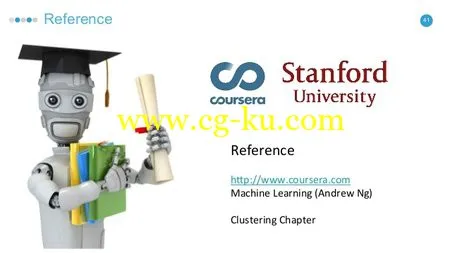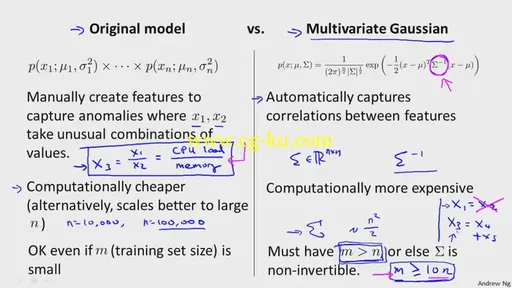
Coursera - Machine Learning (2015)
MP4 | AVC 32kbps | English | 960x540 | 15fps | 19h 53mins | AAC stereo 128kbps | 1.52 GB
Genre: Video Training
Machine learning is the science of getting computers to act without being explicitly programmed. In the past decade, machine learning has given us self-driving cars, practical speech recognition, effective web search, and a vastly improved understanding of the human genome. Machine learning is so pervasive today that you probably use it dozens of times a day without knowing it. Many researchers also think it is the best way to make progress towards human-level AI. In this class, you will learn about the most effective machine learning techniques, and gain practice implementing them and getting them to work for yourself. More importantly, you'll learn about not only the theoretical underpinnings of learning, but also gain the practical know-how needed to quickly and powerfully apply these techniques to new problems. Finally, you'll learn about some of Silicon Valley's best practices in innovation as it pertains to machine learning and AI.
This course provides a broad introduction to machine learning, datamining, and statistical pattern recognition. Topics include: (i) Supervised learning (parametric/non-parametric algorithms, support vector machines, kernels, neural networks). (ii) Unsupervised learning (clustering, dimensionality reduction, recommender systems, deep learning). (iii) Best practices in machine learning (bias/variance theory; innovation process in machine learning and AI). The course will also draw from numerous case studies and applications, so that you'll also learn how to apply learning algorithms to building smart robots (perception, control), text understanding (web search, anti-spam), computer vision, medical informatics, audio, database mining, and other areas.
I. Introduction (Week 1)
(collapsed, click to expand)
Completed Welcome (7 min)
Completed What is Machine Learning? (7 min)
Completed Supervised Learning (12 min)
Completed Unsupervised Learning (14 min)
II. Linear Regression with One Variable (Week 1)
(collapsed, click to expand)
Completed Model Representation (8 min)
Completed Cost Function (8 min)
Completed Cost Function - Intuition I (11 min)
Completed Cost Function - Intuition II (9 min)
Completed Gradient Descent (11 min)
Completed Gradient Descent Intuition (12 min)
Completed Gradient Descent For Linear Regression (10 min)
Completed What's Next (6 min)
III. Linear Algebra Review (Week 1, Optional)
(collapsed, click to expand)
Completed Matrices and Vectors (9 min)
Completed Addition and Scalar Multiplication (7 min)
Completed Matrix Vector Multiplication (14 min)
Completed Matrix Matrix Multiplication (11 min)
Completed Matrix Multiplication Properties (9 min)
Completed Inverse and Transpose (11 min)
IV. Linear Regression with Multiple Variables (Week 2)
(collapsed, click to expand)
Completed Multiple Features (8 min)
Completed Gradient Descent for Multiple Variables (5 min)
Completed Gradient Descent in Practice I - Feature Scaling (9 min)
Completed Gradient Descent in Practice II - Learning Rate (9 min)
Completed Features and Polynomial Regression (8 min)
Completed Normal Equation (16 min)
Completed Normal Equation Noninvertibility (Optional) (6 min)
V. Octave Tutorial (Week 2)
(collapsed, click to expand)
Completed Basic Operations (14 min)
Completed Moving Data Around (16 min)
Completed Computing on Data (13 min)
Completed Plotting Data (10 min)
Completed Control Statements: for, while, if statements (13 min)
Completed Vectorization (14 min)
Completed Working on and Submitting Programming Exercises (4 min)
VI. Logistic Regression (Week 3)
(collapsed, click to expand)
Completed Classification (8 min)
Completed Hypothesis Representation (7 min)
Completed Decision Boundary (15 min)
Completed Cost Function (11 min)
Completed Simplified Cost Function and Gradient Descent (10 min)
Completed Advanced Optimization (14 min)
Completed Multiclass Classification: One-vs-all (6 min)
VII. Regularization (Week 3)
(collapsed, click to expand)
Completed The Problem of Overfitting (10 min)
Completed Cost Function (10 min)
Completed Regularized Linear Regression (11 min)
Completed Regularized Logistic Regression (9 min)
VIII. Neural Networks: Representation (Week 4)
(collapsed, click to expand)
Completed Non-linear Hypotheses (10 min)
Completed Neurons and the Brain (8 min)
Completed Model Representation I (12 min)
Completed Model Representation II (12 min)
Completed Examples and Intuitions I (7 min)
Completed Examples and Intuitions II (10 min)
Completed Multiclass Classification (4 min)
IX. Neural Networks: Learning (Week 5)
(collapsed, click to expand)
Completed Cost Function (7 min)
Completed Backpropagation Algorithm (12 min)
Completed Backpropagation Intuition (13 min)
Completed Implementation Note: Unrolling Parameters (8 min)
Completed Gradient Checking (12 min)
Completed Random Initialization (7 min)
Completed Putting It Together (14 min)
Completed Autonomous Driving (7 min)
X. Advice for Applying Machine Learning (Week 6)
(collapsed, click to expand)
Completed Deciding What to Try Next (6 min)
Completed Evaluating a Hypothesis (8 min)
Completed Model Selection and Train/Validation/Test Sets (12 min)
Completed Diagnosing Bias vs. Variance (8 min)
Completed Regularization and Bias/Variance (11 min)
Completed Learning Curves (12 min)
Completed Deciding What to Do Next Revisited (7 min)
XI. Machine Learning System Design (Week 6)
(collapsed, click to expand)
Completed Prioritizing What to Work On (10 min)
Completed Error Analysis (13 min)
Completed Error Metrics for Skewed Classes (12 min)
Completed Trading Off Precision and Recall (14 min)
Completed Data For Machine Learning (11 min)
XII. Support Vector Machines (Week 7)
(collapsed, click to expand)
Completed Optimization Objective (15 min)
Completed Large Margin Intuition (11 min)
Completed Mathematics Behind Large Margin Classification (Optional) (20 min)
Completed Kernels I (16 min)
Completed Kernels II (16 min)
Completed Using An SVM (21 min)
XIII. Clustering (Week 8)
(collapsed, click to expand)
Completed Unsupervised Learning: Introduction (3 min)
Completed K-Means Algorithm (13 min)
Completed Optimization Objective (7 min)
Completed Random Initialization (8 min)
Completed Choosing the Number of Clusters (8 min)
XIV. Dimensionality Reduction (Week 8)
(collapsed, click to expand)
Completed Motivation I: Data Compression (10 min)
Completed Motivation II: Visualization (6 min)
Completed Principal Component Analysis Problem Formulation (9 min)
Completed Principal Component Analysis Algorithm (15 min)
Completed Choosing the Number of Principal Components (11 min)
Completed Reconstruction from Compressed Representation (4 min)
Completed Advice for Applying PCA (13 min)
XV. Anomaly Detection (Week 9)
(collapsed, click to expand)
Completed Problem Motivation (8 min)
Completed Gaussian Distribution (10 min)
Completed Algorithm (12 min)
Completed Developing and Evaluating an Anomaly Detection System (13 min)
Completed Anomaly Detection vs. Supervised Learning (8 min)
Completed Choosing What Features to Use (12 min)
Completed Multivariate Gaussian Distribution (Optional) (14 min)
Completed Anomaly Detection using the Multivariate Gaussian Distribution (Optional) (14 min)
XVI. Recommender Systems (Week 9)
(collapsed, click to expand)
Completed Problem Formulation (8 min)
Completed Content Based Recommendations (15 min)
Completed Collaborative Filtering (10 min)
Completed Collaborative Filtering Algorithm (9 min)
Completed Vectorization: Low Rank Matrix Factorization (8 min)
Completed Implementational Detail: Mean Normalization (9 min)
XVII. Large Scale Machine Learning (Week 10)
(collapsed, click to expand)
Completed Learning With Large Datasets (6 min)
Completed Stochastic Gradient Descent (13 min)
Completed Mini-Batch Gradient Descent (6 min)
Completed Stochastic Gradient Descent Convergence (12 min)
Completed Online Learning (13 min)
Completed Map Reduce and Data Parallelism (14 min)
XVIII. Application Example: Photo OCR
(collapsed, click to expand)
Completed Problem Description and Pipeline (7 min)
About the Instructor(s)
Professor Andrew Ng is Director of the Stanford Artificial Intelligence Lab, the main AI research organization at Stanford, with 20 professors and about 150 students/post docs. At Stanford, he teaches Machine Learning, which with a typical enrollment of 350 Stanford students, is among the most popular classes on campus. His research is primarily on machine learning, artificial intelligence, and robotics, and most universities doing robotics research now do so using a software platform (ROS) from his group.
In 2008, together with SCPD he started SEE (Stanford Engineering Everywhere), which was Stanford's first attempt at free, online distributed education. Since then, over 200,000 people have viewed his machine learning lectures on YouTube, and over 1,000,000 people have viewed his and other SEE classes' videos.
Ng is the author or co-author of over 100 published papers in machine learning, and his work in learning, robotics and computer vision has been featured in a series of press releases and reviews. In 2008, Ng was featured in Technology Review's TR35, a list of "35 remarkable innovators under the age of 35". In 2009, Ng also received the IJCAI Computers and Thought award, one of the highest honors in AI.


发布日期: 2016-02-18